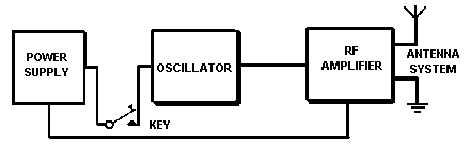1-34
Capacitors C2 and C3 can be GANGED (mechanically linked together) to simplify tuning. Capacitor
C1 is used to tune (resonate) the antenna to the transmitter frequency. CA is the effective capacitance
existing between the antenna and ground. This antenna-to-ground capacitance is in parallel with the
tuning capacitors, C2 and C3. Since the antenna has capacitance, any change in its length or position,
such as that caused by swaying of the antenna, changes the value of CA and causes the oscillator to
change frequency. Because these frequency changes are undesirable for reliable communications, the
multistage transmitter was developed to increase reliability.
Multistage Transmitters
The simple, single-tube transmitter, shown in figure 1-28, is rarely used in practical equipment. Most
of the transmitters you will see use a number of tubes or stages. The number used depends on the
frequency, power, and application of the equipment. For your study, the following three categories of cw
transmitters are discussed: (1) master oscillator power amplifier (mopa) transmitters, (2) multistage,
high-power transmitters, (3) high- and very-high frequency transmitters.
The mopa is both an oscillator and a power amplifier. Power-amplifying stages and frequency-
multiplying stages must be used to increase power and raise the frequency from those achievable in a
mopa. The main difference between many low- and high-power transmitters is in the number of power-
amplifying stages that are used. Similarly, the main difference between many high- and very-high
frequency transmitters is in the number of frequency-multiplying stages used.
MASTER OSCILLATOR POWER AMPLIFIER.—For a transmitter to be stable, its oscillator
must not be LOADED DOWN. This means that its antenna (which can present a varying impedance)
must not be connected directly to the oscillator circuit. The rf oscillations must be sent through another
circuit before they are fed to the antenna for good frequency stability to be obtained. That additional
circuit is an rf power amplifier. Its purpose is to raise the amplitude of rf oscillations to the required
output power level and isolate the oscillator from the antenna. Any transmitter consisting of an oscillator
and a single-amplifier stage is called a master oscillator power amplifier transmitter (mopa), as shown in
figure 1-29.
Figure 1-29.—Block diagram of a master oscillator power amplifier transmitter (mopa).
Most mopa transmitters have only one tube amplifier in the power-amplifier stage. However, the
oscillator may not produce sufficient power to drive a power-amplifier tube to the power output level
required for the antenna. In such cases, the power-amplifier stages are designed to use two or more
amplifiers which can be driven by the oscillator. Two or more amplifiers can be connected in parallel
(with similar elements of each tube connected) or in a push-pull arrangement. In a push-pull amplifier, the
grids are fed equal rf voltages that are 180 degrees out of phase.
The main advantage of a mopa transmitter is that the power-amplifier stage isolates the oscillator
from the antenna. This prevents changes in antenna-to-ground capacitance from affecting the oscillator

